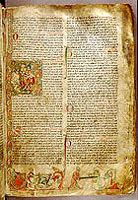The
History of Iceland's Sagas
by Bob
Brooke
 The
sagas are a unique medieval literature to which I will continually refer
and sometimes quote throughout this book. The word saga can be
translated into English as "history;" hence, the Icelandic
series slendinga Saga would be translated as History of the
Icelanders. In English, however, sagas are the histories written down in
Iceland from the 12th through the 14th, but particularly the 13th, centuries. The
sagas are a unique medieval literature to which I will continually refer
and sometimes quote throughout this book. The word saga can be
translated into English as "history;" hence, the Icelandic
series slendinga Saga would be translated as History of the
Icelanders. In English, however, sagas are the histories written down in
Iceland from the 12th through the 14th, but particularly the 13th, centuries.
There are various kinds
of sagas from this time--those that deal with ancient, former, and
contemporary times, and those that are more self-consciously historical.
The sagas of ancient times are heroic accounts of the Germanic peoples
during the migration period during the 5th and 6th centuries), while the
sagas of former times deal with the first settlers and the early
generations of Icelanders. This latter category is conventionally called
the sagas of the Icelanders or the family sagas or just the sagas There
are about 40 sagas in existence, ranging in length from a few pages to
300 or 400 pages in conventional book form. They describe in a highly
realistic and exterior way, in a style similar to Hemingway's, the
tumultuous lives of leading Icelandic farming families during the tenth
and eleventh centuries, their feuds and their alliances. However, these
accounts were not put down on parchment until the late 12th and 13th
centuries, two centuries after the purported events they describe. How
much they're historical accounts and how much fiction has been a point
of intense controversy for the better part of a century.
According to Peter
Hallberg, the sagas are believed to be essentially historical. They
developed in close connection with the described events, were
transmitted from generation to generation by storytellers, and were
finally committed to parchment, generally sometime during the 13th
century.
The authors of the
sagas merely recorded a fixed oral tradition. On the other hand, they
have been regarded by some scholars primarily as works of fiction.
The overwhelmingly dominant opinion among
current literary and historical scholars of the Icelandic Middle Ages is
that the sagas are fictional works of art, not historical accounts.
Sigurour Nordal's studied
Hrafnkel's Saga, a short, particularly realistic, unexaggerated,
believable account of the conflicts among farmers in the eastern fjords.
Through close internal and external analysis, Nordal effectively
demolished the historical account of this saga, previously thought to be
among the most historically reliable, and showed it to be an elegantly
crafted short story.
However, even Nordal, who
was extreme among saga scholars in his argument that the sagas must be
regarded primarily as works of fiction, would never have denied the link
to history of most of the leading saga personalities nor that the sagas
are, to various degrees, based on actual historical events.
Most significantly, he
regarded the artistic success of the 13th-Century saga authors to be the
result of their ability to create the appearance of historical reality.
According to Nordal, the
writers of the Family Sagas were better off than might be expected when
describing times so long past. “The changes in the social and material
conditions, in housing, clothes, weapons, seamanship, and so on, were
not very remarkable from the 10th to the 13th Century, and obvious
anachronisms in such descriptions are rare. “The writers were quite
conscious of the distance in time, and they had a considerable
historical sense,” he said.
One saga scholar, Jesse
Byock noted that Nordal and "so many" of his contemporaries
were "virtually blind to the fact that the sagas would be an
important resource for today's interest in the function of society and
traditional patterning."
But the saga scholars
aren't alone in their beliefs. The anthropologist Rosalie H. Wax noted
that "most of those Old Icelandic and Old Scandinavian materials
[fall] squarely into an area of investigation to which anthropologists
and sociologists have been selectively inattentive." She later
noted that she does "not believe that there's any other record of
comparable richness, volume, and interest in the world."
Her sentiments are echoed
by another anthropologist, Victor W. Turner, who observed that the sagas
"are many and rich and full of the very materials that
anthropologists rejoice in when vouchsafed to them by informants in the
field." In one place, he calls Njal's Saga an "anthropological
paradise.'"
Turner emphasized that
the "major continuities" between the Saga Age and the 13th
Century are "so many" . . .at the basic levels of kinship and
territorial organization, mode of subsistence, forms of adjudication and
arbitration, and norms governing relations between individuals and
groups, that sagas treating both the earlier and later periods can be
regarded equally as models of and for Icelandic social life as it lasted
over several centuries.
To read more articles by
Bob Brooke, please visit his Web
site.
|